
Elliott Key is hot spot for local boaters
ELLIOTT KEY, Fla.— Imagine taking a short boat ride across the openness of blue-green waters and all you need is a few peanut butter and jelly sandwiches and a bathing suit.
This is the Elliott Key experience.
Time slows down here. Many visitors to this island relax in the sun or take part in a variety of water activities from swimming to fishing.
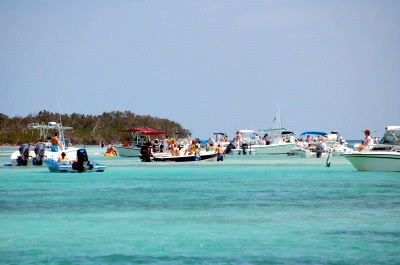 |
The weekend crowd is thick with recreational boaters off the shores of Elliott Key in Biscayne National Park (Photo by Andrea Dale). |
“Elliott Key is gorgeous. It’s probably one of the best places in Miami for cruising and staying overnight,” Esteban Dozsa, a boater for 10 years, said.
Elliott Key is the northernmost of the true Florida Keys and the largest key north of Key Largo. It is a part of Biscayne National Park, which has over 500 different species of fish. The key is also used by boaters as a landmark for good snorkeling and other water sports, in which many tourists and visitors enjoy.
“There are many places around the island that have good snorkeling such as Sandwich Cove, Hurricane Reef and Mandalay Wreck. Other sites like Alicia Wreck and Schooner Wreck are best for diving,” Biscayne National Park Ranger Gary Bremen said.
The key is located about 12 miles off the coast of mainland Florida and is seven miles long. It lies sandwiched in between two other smaller keys: Sands Key to the north and Old Rhodes Key to the south. Adams Key is another much smaller island, which is located at the southwest end of Elliott Key.
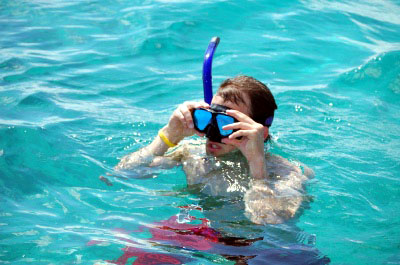 |
A snorkeler in the clear waters off Elliott Key in Biscayne National Park (Photo by Andrea Dale). |
There is a legend of Elliott Key and the other keys around it, which states that it use to be used as a refuge by pirates and escaped slaves. The best-known pirate of this legend was named Black Caesar and it is said that he escaped from a slave ship and used Elliott Key as his base of operations.
In the later part of the 19th Century and the first half of the 20th Century, Elliott Key was the site of a pineapple plantation. By 1910, more than a dozen families lived there and worked in the plantations.
During the 1950s a causeway was proposed that would connect Elliott Key and the surrounding keys to Key Biscayne and Key Largo. However, this was stopped in 1968 when Elliott Key and the other keys all became protected land with the establishment of the Biscayne National Monument.
Some boaters go out for only a few hours at a time, while others stay out for days or even weeks.
“On Columbus Day, anywhere from 700 to 2,000 boats visit Elliott Key on that day alone,” Bremen said.
| Boaters gather at a popular spot near Elliott Key in Biscayne National Park (Photo by Andrea Dale). |
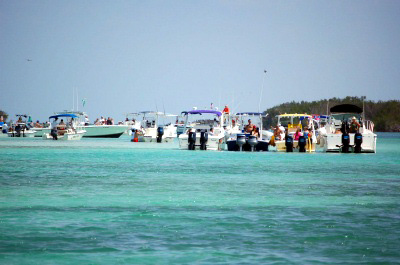 |
Inexperienced boaters, who are not familiar with the area, contribute to the growing problem of killing seagrass by coming aground. When a boat comes aground, it often kills valuable sea life such as seagrass, which provides a protected habitat for young fish to develop.
“I think it’s a good idea once in a lifetime to do it, to gain the experience,” Dozsa said.
Off Elliott Key there is a place where seagrass use to flourish, which has been transformed over the years into a hot spot for partiers. The continuous treading and grounding of boats in this particular area, has completely eased all traces of seagrass or sea life. What use to be seagrass now resembles a sandbar, even though it was never meant to be.
“During the Columbus Day weekend this happens on a much larger scale,” Bremen said.
The growth of uneducated and careless boaters, throughout the years, has greatly contributed to the areas demise. More boating education will help to prevent future damage to marine life, and help keep the park a safe environment for all who visits as well.
“It is important for all boaters who plan on visiting Biscayne National Park, to have a good boater education and to carry maps with them as guides through the park,” Bremen said.
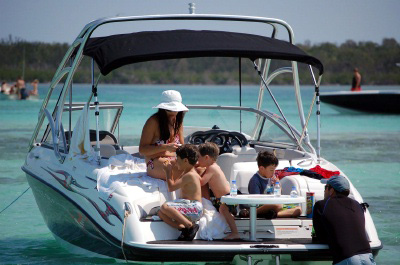 |
Boaters enjoy the weekend weather off Elliott Key in Biscayne National Park (Photo by Andrea Dale). |
If You Go:
Biscayne National Park
9700 SW 328th St., Homestead, Fla. 33033-5634
305-230-7275, http://www.nps.gov/bisc/
Boat tours offer glass-bottom boat tours, snorkeling and scuba diving trips to the reefs, and occasional island excursions for picnicking and hiking. All of these activities leave from Convoy Point. Equipment rentals are also available.
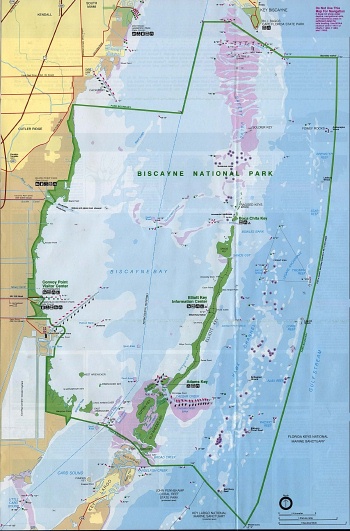 Hours of Operation: The Convoy Point complex is open from 7 a.m. to 5:30 p.m. daily (closed on Christmas Day) with the Visitor Center open from 8:30 p.m. to 5 p.m.
Hours of Operation: The Convoy Point complex is open from 7 a.m. to 5:30 p.m. daily (closed on Christmas Day) with the Visitor Center open from 8:30 p.m. to 5 p.m.
For more information about tours or to make reservations contact: Biscayne National Underwater Park, 9710 SW 328 th St., Homestead, FL 33033, 305-230-1100.
Directions to Convoy Point and Dante Fascell Visitor Center:
From North:
From the Florida Turnpike: Take the Florida Turnpike south, to Exit 6 ( Speedway Boulevard). Turn left from exit ramp and continue south to SW 328th Street ( North Canal Drive). Turn left and continue to the end of the road. It is approximately five miles, and the entrance is on the left.
From U.S. 1: Drive south to Homestead. Turn left on SW 328th Street ( North Canal Drive), and continue to the end of the road. It is approximately nine miles, and the entrance is on the left.
From South:
From U.S. 1, drive north to Homestead. Turn right on SW 328th Street (North Canal Drive— first light after Florida Turnpike entrance), and continue to the end of the road. It is approximately nine miles, and the entrance is on the left.
Accommodations: The surrounding cities of the park such as Homestead, Miami and Florida City have hotel and motel accommodations; reservations are recommended. There are many grocery stores, restaurants, service stations and other stores in the area as well.
Public marinas nearby offer boat launch ramps and fuel, as well as charters and sail boat or motor boat rentals.
Public Marinas Near Biscayne National Park:
Black Point Marina (Miami-Dade County): 24775 SW 87 Ave., Cutler Ridge, Fla. 33032, 305-258-4092. Hours: Dock office: 8:30 a.m. – 4:45 p.m., fuel dock, weekdays 8 a.m. – 7 p.m., weekends 6 a.m. – 10 p.m.
Homestead Bayfront Park and Herbert Hoover Marina (City of Homestead): 9698 SW 328th St., Homestead, FL 33035, 305-230-3034, Hours: Mondays to Sundays 7 a.m. – 7 p.m.

Comments are Closed